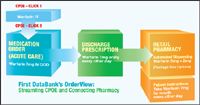New Pharma knowledge base streamlines CPOE
Although computerized physician order entry (CPOE) offers the potential to save lives and reduce medical costs, it hasn't yet garnered widespread acceptance. According to the results of a questionnaire administered in a study by Harvey Murff, M.D., of Brigham & Women's Hospital in Boston and Joseph Kannry, M.D., of Mount Sinai-NYU Health Systems in New York, published in the Journal of the American Medical Informatics Association, one of the biggest obstacles to acceptance is the difficulty of executing tasks "in a straightforward manner." Physicians find it takes longer to type prescriptions into the system than it does to write prescriptions on a pad in the traditional way.

Suppose there were a way to streamline the process of entering orders that made it as fast as jotting a prescription on a pad, and, for more complex prescriptions, even faster. According to First Databank of San Bruno, Calif., one now exists.
At the recent annual Healthcare Information & Management Systems Society (HIMSS) conference in San Diego, First Databank announced the launch of its OrderView Med Knowledge Base, which, according to the company, is the first commercial medication database designed specifically for CPOE streamlined for this practice. It's "order-centric," according to First DataBank's product management director, Virginia Halsey.
To enter an order into a CPOE system employing OrderView, the user enters the first few letters of the name of the drug to be prescribed. This leads the user to the base of a branch of the OrderView medication knowledge tree, and the prescription can most often be completed with two mouse clicks. The organization of the information into branches of a tree minimizes scrolling through long lists on the screen, a task that plagued many of the early systems.
In addition, the OrderView knowledge base enables CPOE systems to identify common routes for priority display. While less common routes are recognized by the system, they can be handled differently, depending on the needs of end users. Differential prioritizing can also reduce time spent scrolling through long lists.
The order-centric nature of this knowledge base also spares physicians from seeing unnecessary information, i.e., they need not enter product dispensing information, which is not their responsibility. Clinicians who enter "warfarin oral" would invoke a "stepping-stone" that leads them directly to a completed order-e.g., "warfarin 7mg po qday"-with just one click. They would never have to give instructions to make up a 7-mg order by using a 5-mg tablet and a 2-mg tablet (two of the available tablet sizes). The knowledge base automatically specifies the 5-mg/2-mg combination when it receives the information that the total dose is to be 7 mg.
This knowledge base can also handle discretionary orders, which are carried out differently depending on patient status or some other parameter. For example, when a drug such as acetaminophen is to be given either PO or PR, depending on the status of the patient, some CPOE systems require two separate orders-a requirement that may even trigger a duplicate therapy alert. OrderView's flexibility allows combining both options into one Rx, thus cutting out the time it takes to write the second prescription and, when an alert for duplicate therapy is triggered, the time it takes to respond to the alert. OrderView also facilitates changing existing prescriptions and can transfer medication orders seamlessly into pharmacy systems without the need for retyping.
THE AUTHOR is a writer based in San Diego.